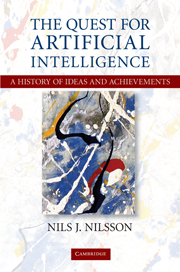Book contents
- Frontmatter
- Contents
- Preface
- PART I BEGINNINGS
- PART II EARLY EXPLORATIONS: 1950S AND 1960S
- PART III EFFLORESCENCE: MID-1960S TO MID-1970S
- 9 Computer Vision
- 10 “Hand-Eye” Research
- 11 Knowledge Representation and Reasoning
- 12 Mobile Robots
- 13 Progress in Natural Language Processing
- 14 Game Playing
- 15 The Dendral Project
- 16 Conferences, Books, and Funding
- PART IV APPLICATIONS AND SPECIALIZATIONS: 1970s TO EARLY 1980s
- PART V “NEW-GENERATION” PROJECT
- PART VI ENTR'ACTE
- PART VII THE GROWING ARMAMENTARIUM: FROM THE 1980s ONWARD
- PART VIII MODERN AI: TODAY AND TOMORROW
- Index
- Plate section
10 - “Hand-Eye” Research
Published online by Cambridge University Press: 05 August 2013
- Frontmatter
- Contents
- Preface
- PART I BEGINNINGS
- PART II EARLY EXPLORATIONS: 1950S AND 1960S
- PART III EFFLORESCENCE: MID-1960S TO MID-1970S
- 9 Computer Vision
- 10 “Hand-Eye” Research
- 11 Knowledge Representation and Reasoning
- 12 Mobile Robots
- 13 Progress in Natural Language Processing
- 14 Game Playing
- 15 The Dendral Project
- 16 Conferences, Books, and Funding
- PART IV APPLICATIONS AND SPECIALIZATIONS: 1970s TO EARLY 1980s
- PART V “NEW-GENERATION” PROJECT
- PART VI ENTR'ACTE
- PART VII THE GROWING ARMAMENTARIUM: FROM THE 1980s ONWARD
- PART VIII MODERN AI: TODAY AND TOMORROW
- Index
- Plate section
Summary
The motivation for much of the computer vision research that i have described during this period was to provide information to guide a robot arm. Because the images that could be analyzed best were of simple objects such as toy blocks, work was concentrated on getting a robot arm to stack and unstack blocks. I'll describe some typical examples of this “hand–eye” research, beginning with a project that did not actually involve an “eye.”
At MIT
A computer-guided mechanical “hand” was developed by Heinrich A. Ernst in 1961 as part of his Electrical Engineering Sc.D. work at MIT. (His advisor was Claude Shannon.) The hand, named MH-1, was a “mechanical servomanipulator [an American Machine and Foundry model 8] adapted for operation by the TX-0 computer.” It used tactile sensors mounted on the hand to guide it because, as Ernst wrote, “organs for vision are too difficult to build at the present time.” The abstract of Ernst's thesis describes some of what the system could do:
[O]ne program consisting of nine statements will make the hand do the following: Search the table for a box, remember its position, search the table for blocks, take them and put them into the box. The position of the objects is irrelevant as long as they are on the table. […]
Information
- Type
- Chapter
- Information
- The Quest for Artificial Intelligence , pp. 141 - 148Publisher: Cambridge University PressPrint publication year: 2009
